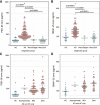Increased levels of the synaptic proteins PSD-95, SNAP-25, and neurogranin in the cerebrospinal fluid of patients with Alzheimer's disease
- PMID: 35461266
- PMCID: PMC9034610
- DOI: 10.1186/s13195-022-01002-x
Increased levels of the synaptic proteins PSD-95, SNAP-25, and neurogranin in the cerebrospinal fluid of patients with Alzheimer's disease
Abstract
Background: There is currently a lack of reliable and easily accessible biomarkers predicting cognitive decline in Alzheimer's disease (AD). Synaptic dysfunction and loss occur early in AD and synaptic loss measured in the brain tissue and by PET are closely linked to cognitive decline, rendering synaptic proteins a promising target for biomarker development.
Methods: We used novel Simoa assays to measure cerebrospinal fluid (CSF) levels of two synaptic biomarker candidates, postsynaptic density protein 95 (PSD-95/DLG4), and the presynaptically localized synaptosomal-associated protein 25 (SNAP-25), as well as neurogranin (Ng), an established postsynaptic biomarker. CSF samples from two well-characterized cohorts (n=178 and n=156) were selected from banked samples obtained from diagnostic lumbar punctures containing subjects with amyloid-ß (Aß) positive AD, subjects with non-AD neurodegenerative diseases, subjects with other neurological conditions, and healthy controls (HC).
Results: All subjects had detectable CSF levels of PSD-95, SNAP-25, and Ng. CSF levels of PSD-95, SNAP-25, and Ng were all correlated, with the strongest correlation between the presynaptic SNAP-25 and the postsynaptic neurogranin. AD subjects had on average higher concentrations of all three synaptic markers compared to those with non-AD neurodegenerative diseases, other neurological disorders, and HCs. Increased CSF levels of PSD-95, SNAP-25, and Ng were, however, not specific for AD and were present in sporadic cases with inflammatory or vascular disorders as well. High CSF levels of PSD-95 were also observed in a few subjects with other neurodegenerative disorders.
Conclusion: The data establishes PSD-95 as a promising CSF marker for neurodegenerative disease synaptic pathology, while SNAP-25 and Ng appear to be somewhat more specific for AD. Together, these synaptic markers hold promise to identify early AD pathology, to correlate with cognitive decline, and to monitor responses to disease-modifying drugs reducing synaptic degeneration.
Keywords: Alzheimer’s disease; Biomarkers; Cerebrospinal fluid; Neurodegenerative diseases; Neurogranin; PSD-95; SNAP-25; Synaptic markers.
© 2022. The Author(s).
Conflict of interest statement
S. Arnold has received honoraria and/or travel expenses for lectures from Abbvie, Eisai, and Biogen and has served on scientific advisory boards of Corte, has received consulting fees from Athira, Cassava, Cognito Therapeutics, EIP Pharma and Orthogonal Neuroscience, and has received research grant support from NIH, Alzheimer’s Association, Alzheimer’s Drug Discovery Foundation, Abbvie, Amylyx, EIP Pharma, Merck, Janssen/Johnson & Johnson, Novartis, and vTv. M. Mendes and M. Brock are paid employees of Quanterix Corporation. C. Rubel, J. Czerkowicz, and D. Graham are paid employees of Biogen. The other authors report no declaration of interest.
Figures




References
Publication types
MeSH terms
Substances
Grants and funding
LinkOut - more resources
Full Text Sources
Other Literature Sources
Medical
Molecular Biology Databases
Miscellaneous

